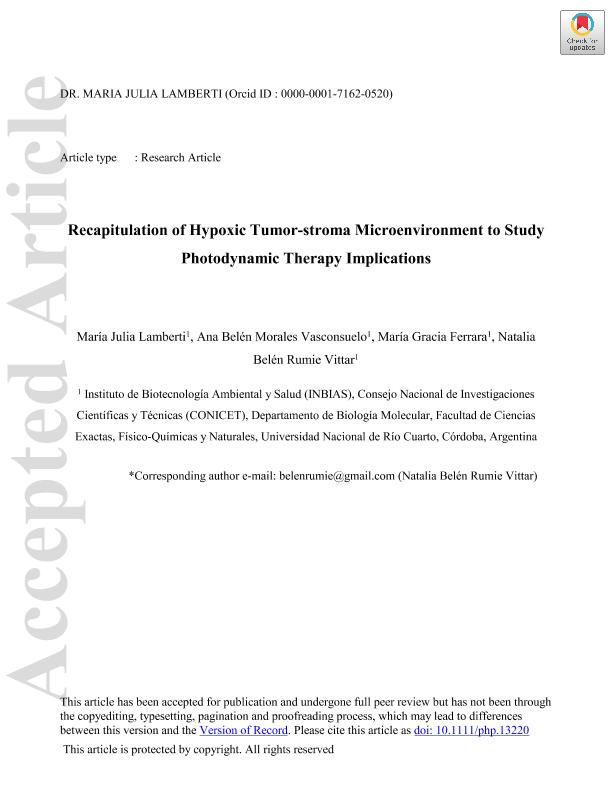Artículo
Recapitulation of Hypoxic Tumor–stroma Microenvironment to Study Photodynamic Therapy Implications
Lamberti, María Julia ; Morales Vasconsuelo, Ana Belen
; Morales Vasconsuelo, Ana Belen ; Ferrara, Maria Gracia
; Ferrara, Maria Gracia ; Rumie Vittar, Natalia Belen
; Rumie Vittar, Natalia Belen
 ; Morales Vasconsuelo, Ana Belen
; Morales Vasconsuelo, Ana Belen ; Ferrara, Maria Gracia
; Ferrara, Maria Gracia ; Rumie Vittar, Natalia Belen
; Rumie Vittar, Natalia Belen
Fecha de publicación:
07/2020
Editorial:
Wiley Blackwell Publishing, Inc
Revista:
Photochemistry and Photobiology
ISSN:
0031-8655
Idioma:
Inglés
Tipo de recurso:
Artículo publicado
Clasificación temática:
Resumen
Tumor microenvironment (TME) is a dynamic ecosystem where fibroblasts are recruited in order to provide a niche to support growth and, in some extent, to promote therapeutic resistance. However, the role of fibroblasts in stimulating or impairing photodynamic therapy (PDT) outcome has not yet been fully addressed. PDT is based on interactions between light, oxygen and photosensitizer, leading to phototoxic reactions that culminate in cell death. In this study, we demonstrated the consequences of a hypoxic stromal phenotype on tumor mass for exploring PDT response. We mimicked TME complexity implementing colon cancer cells and fibroblasts 3D cultures called spheroids. Using hypoxia reporting lines, we verified that homotypic spheroids exhibited a size-dependent transcriptional HIF-1 activity. When cocultured, fibroblasts were localized in the hypoxic core. In homotypic stromal spheroids, the distribution of the endogenous photosensitizer PpIX was homogeneous while decreased in hypoxic areas of tumor 3D cultures. When monocultured, fibroblasts were more efficient to produce PpIX from its prodrug Me-ALA. Interestingly, the cross talk between cancer cells and fibroblasts attenuated PpIX accumulation and conferred tumor PDT resistance when compared to homotypic 3D cultures. Overall, our data suggest that stroma and tumor act in an integrated, reciprocal fashion which could ultimately influence on therapeutic response.
Palabras clave:
Tumor microenvironment
,
hypoxia
,
fibroblats
,
Photodynamic Therapy
Archivos asociados
Licencia
Identificadores
Colecciones
Articulos (INBIAS)
Articulos de INSTITUTO DE BIOTECNOLOGIA AMBIENTAL Y SALUD
Articulos de INSTITUTO DE BIOTECNOLOGIA AMBIENTAL Y SALUD
Citación
Lamberti, María Julia; Morales Vasconsuelo, Ana Belen; Ferrara, Maria Gracia; Rumie Vittar, Natalia Belen; Recapitulation of Hypoxic Tumor–stroma Microenvironment to Study Photodynamic Therapy Implications; Wiley Blackwell Publishing, Inc; Photochemistry and Photobiology; 96; 4; 7-2020; 897-905
Compartir
Altmétricas



